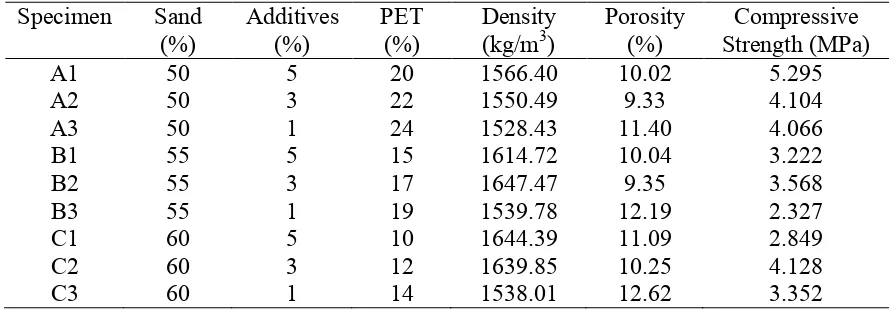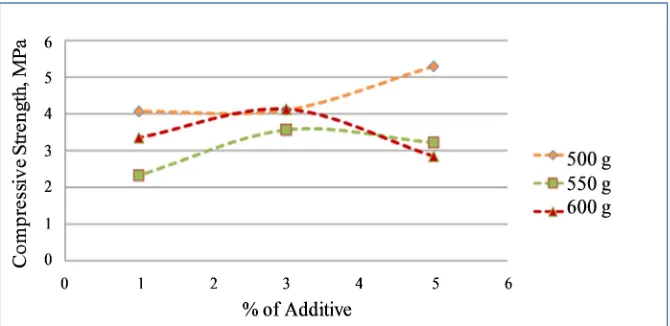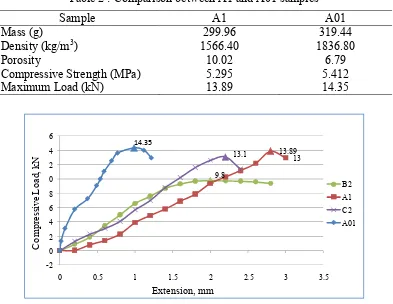Effect pf Thermoplastic Polymer Waste (PET) in Lightweight Concrete
M. A. M. Daud
a, M. Z. Selamat
band A. Rivai
cDepartment of Structure & Materials, Faculty of Mechanical Engineering, Universiti Teknikal Malaysia Melaka, 75450, Ayer Keroh, Melaka, Malaysia.
a
ahadlin@utem.edu.my (corresponding author), bzulkeflis@utem.edu.my,
ahmadrivai@utem.edu.my
Keywords: Thermoplastic Polymer, Lightweight Concrete, PET, Porosity, Density
Abstract. Contruction concrete that use of insulation wall in building construction faces some problems such as having high weight, very reflective sound, heat transfer (the effectiveness of heat conductivity) incompetence and mechanical properties (strength) constraints. The sounds which impinge the wall cannot be absorbed efficiently but instead gives high reflection. This causes some noise of high echo in a room. So a good acoustic insulation must be efficient in absorbing the sound. This project proposes lightweight concrete as a replacement for insulation wall. This lightweight concrete will be developed using thermoplastic polymer waste which is recycled plastic bottles, sand, water, and cement. This research used thermoplastic polymer waste which is PET (Polyethylene Terephthalate) material as the reinforcement material to replace small gravel in lightweight concrete. All its composition percentage of raw materials was divided into different samples composition. Its composition determines the performances of the samples in density, porosity and mechanical properties.
Introduction
Lightweight aggregates were used for lightweight concrete construction. Forming agent such as aluminum powder also can be used which generates gas while the concrete is still plastic. Natural lightweight aggregates include pumice, scoria, volcanic cinders, tuff, and diatomite. Lightweight aggregate can also be produced by heating clay, shale, slate, diatomaceous shale, perlite, obsidian, and vermiculite. Industrial cinders and blast furnace slag that have been specially cooled can also be used [1,2]. Pumice and scoria were the most widely used substances for natural lightweight aggregates. They can be found in Western United State which come in various colors, porous and froth-like volcanic glass. A strong concrete as an ordinary concrete was made up from expanded shale and clay, but its insulation value is about four times better. A concrete of intermediate strength, but with even more impressive value as insulation was produced by pumice, scoria, and some expanded slag. For the very low strength of concrete, but with superior insulation properties, they were made from perlite, vermiculite, and diatomite. However it is producing more shrinkage [3].
Concrete is a construction material cement based adhesive, and the aggregate of: sand and stone (gravel). This product will modify the use of materials that have been commonly used in the manufacturing of the concrete so as to produce concrete material better than the existing concrete and used for this. Modification of this product still refers to the standard design requirement which has already existed. The product includes the replacements of modified binder (cement) with a thermoplastic material and replace the gravel the whisker of PET (Polyethylene Terephthalate). Up to this date, there is sheer growing interest Until now, there has growing interest in studies on effect of polymer to composite structure [4,5,6]. They found that the resulting products were lighter and have a low of the wet ability by water.
The objective of the study is to develop a polymer binder product with additives and the application of short (aggregate) PET (Polyethylene Terephthalate)polymer waste instead of gravel aggregate in the concrete matrix.
Experimental Procedure
The research is a laboratory scale to determine the optimum composition of the manufacturing of lightweight concrete by replacing the gravel with thermoplastic waste material which is PET (Polyethylene Terephthalate). Specimen was made up from different percentage composition of sand, cement, PET (Polyethylene Terephthalate), water, and additives. This research involves compression test, density and porosity test, and thermal conductivity test. All concrete samples have undergone physical and mechanical properties testing after reaching room temperature that consist of ASTMC39 Test Press (Compressive) and Test ASTM C373-88 Density and Porosity.
In addition, the sample best result which was the highest value of load and compressive strength that they can stand has undergone Thermal Properties Test to determine the value of thermal conductivity. The Apparent porosity and density of specimens measuring diameter 57 mm by 60 mm high was estimated by the Archimedes method using kerosene (ASTM C 380-79). Subsequently their specific gravities were determined by dividing the unit weight of the sample by the unit volume.
Density, = (1)
Where m is the weight dry sample (kg), V is the volume cylinder (m3), and ρ is density of the concrete sample (kg/m³).The porosity was determined using the equation such as follows:
% Porosity = 100% (2)
Figure 1 shows the density values for each sample from group A, B and C. The percentage of PET waste for sample A is between 20%-24% where it is the highest amount compared to sample B and C where the PET waste amount are between 15%-19% and 10%-14% respectively. The density values obtained show that sample A has low density. This means the lightweight concrete produced were light in weight. This is because of the properties or characteristics of PET waste are light in weight. Group B and C have less percentage of PET waste but have more amount of sand. This makes the density values higher compared to sample A.
Table 1 : Density, Porosity and Compressive Strength of Lightweight Concrete
Fig. 1 : Percentage of PET Waste and Density for samples A, B and C
Figure 2 shows the result of compressive strength from compression testing for all samples from group A, B and C that marked as 500 g, 550 g and 600 g respectively. Based on the graph, sample A with 500 g sand, the compressive strength increased as the percentage of additive increased. This shows that the additives reacted as binder between the raw materials when they were mixing together. The more additives applied to these samples the stronger bonds were existed between them. Thus it produced less porosity in the structure. The main purpose additive usage was to make the PET waste material to make bonding with the other materials [8,9]. The same results go to sample B and C with 550 g and 600 g sand respectively.
However, at the 5% of additive the compressive strength decreased. The amount of sand and PET waste may have affected the strength values. This is because for sample with 5% additives the amounts of PET waste are higher compared to sample with 1% and 3% additive. Couple with the amount of sand is more than sample A, all the materials were not fully mixed during concrete preparation processes. In addition, the amount of additive is perhaps insufficient to make the strong bonding between PET waste and the other materials. Thus it produced low strength.
Fig. 2 : Percentage of Addtive Waste and Compressive Strength for difference weight of sand
Table 2 : Comparison between A1 and A01 samples
Fig. 3 : Compressive Extension and Compressive Load of Lightweight Concrete
Conclusion
Experimental investigation on the effect of polymer waste on lightweight concrete was carried out. Based on the results the following conclusion are made:
1. The highest and the lowest value of density and porosity among the nine samples of lightweight concrete are 1647.47 kg/m³ and 9.33%.
2. The highest compressive strength and maximum load are 5.295 MPa and 13.89 kN.
3. The optimal percentage composition of raw material to produce the optimal result was determined as in sample A1 with 50% sand, 25% cement, 20% PET Waste, 5% Additive and 40% water.
Acknowledgements
The author would like to thanks to the Department of Structure and Materials, Faculty of Mechanical Engineering, University Technical Malaysia Melaka for providing financial, infrasture and supporting for this research.
References
[1] A.M. Neville: Properties of Concrete. Fourth and Final Edition, Longman, Malaysia, VV P, (1996), pp. 688-708.
[2] ACI Committee 213: Guide for structural lightweight aggregate concrete. ACI Manual of Concrete Practice: Part I. American Concrete Institute, Detroit. (1994).
[3] K. Kohno, T. Okamoto, Y. Isikawa, T. Sibata and H. Mori, Effects of artificial lightweight aggregate on autogenous shrinkage of concrete. Cem. Concr. Res. 29. (1999) 611-614.
[4] J.A. Rossignolo and M.V.C. Agnesini: Mechanical properties of polymer modified lightweight aggregate concrete. Cem. Concr. Res. 32. (2001) 329-334.
[5] F. Blanco, P. Garcia, P. Mateos and J. Ayala: Characteristics and properties of lightweight concrete manufactured with cenospheres. Cem. Concr. Res. 30. (2000) 1715-1722.
[6] Y.W. Choi, J.S. Chung, D.J. Moon, H.C. Shin and Y.T. Hwang: An experimental study on properties of lightweight concrete using PET bottles. Proc. Korea Concr. Ins. 14. (2002) 211-216.
[7] National Ready Mixed Concrete Association: Concrete In Practice 36 Structural Lightweight Concrete. (2003) Information on http://www.countymaterials.com/literature / item/cip-36-structural-lightweightconcrete.
[8] Y.W. Choi, D.J. Moon, J.S. Chung, and S.K. Cho: Effect of waste PET bottles aggregate on the properties of concrete. Cement and Concrete Research. 35. (2005) 766-781.


